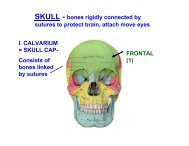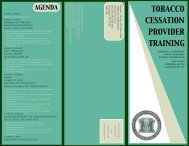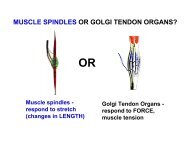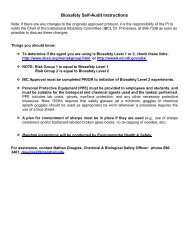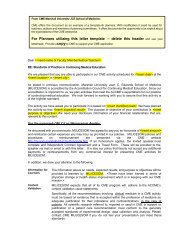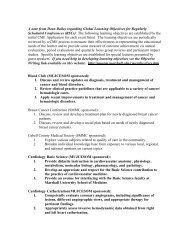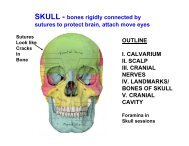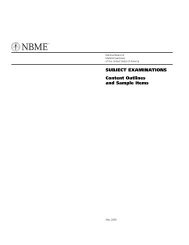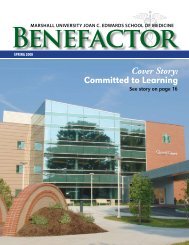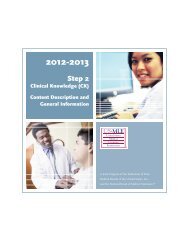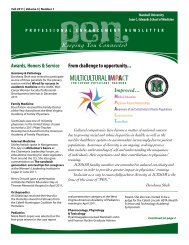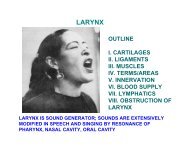FA 5 Progress Report WV-INBRE - Joan C. Edwards School of ...
FA 5 Progress Report WV-INBRE - Joan C. Edwards School of ...
FA 5 Progress Report WV-INBRE - Joan C. Edwards School of ...
- No tags were found...
Create successful ePaper yourself
Turn your PDF publications into a flip-book with our unique Google optimized e-Paper software.
Program Director/Principal Investigator (Last, First, Middle): Rankin, Gary O 55Methods: Peripheral blood samples were collected from diagnosed ischemic stroke patients within24 hours from last known normal and 24-48 hours later.Total RNA was extracted from whole bloodstabilized in PAXgene RNA tubes, amplified, and hybridized to Illumina HumanRef-8v2 bead chips.Gene expression was compared in a univariate manner between stroke patients at both time pointsand outcome using t-test in GeneSpring. Inflation <strong>of</strong> type one error was corrected by Bonferroni andIngenuity Systems Pathway analysis (IPA) was performed. A validation cohort <strong>of</strong> n=10 ischemicstroke patients was recruited from <strong>WV</strong>U Ruby Memorial Hospital. Following cDNA amplification <strong>of</strong>whole blood RNA, real-time PCR was completed using TaqMan probes specific for Arg1, CA4,CCR-7, CSPG2, IQGAP, LY96, MMP-9, Orm1, S100A12, TLR2 or TLR4 and β-Actin was used asa housekeeping control. In addition, a retrospective study <strong>of</strong> n=122 patients who underwentendovascular therapy for acute ischemic stroke (AIS) from 2008-2011 was conducted to identifythe relationship between the neutrophil-lymphocyte stress factor (NLSF) and 90 day strokerecovery. An additional component <strong>of</strong> this project is the measurement <strong>of</strong> gene expression at 5 dayspost-stroke; recruitment is ongoing for this part <strong>of</strong> the project and is scheduled to be completed byJune 2012.Results: There were 21 genes with 1.5 fold difference in expression (Bonferroni corrected p2 fold(LY96, IL8, and SDPR). Pathway analysis revealed cytotoxic t-lymphocyte antigen 4 (CTLA4) anddopamine signaling as highly significant pathways present in the peripheral whole blood <strong>of</strong> ISpatients 24-48 hrs post onset <strong>of</strong> symptoms. Seven genes were significantly associated with 30 dayMRS, with Arginase 1 (ARG1) (p=8.58E-06) being the most significant. Follow up expression <strong>of</strong>ARG1 was significantly correlated with MRS (Pearson 0.72; p=0.000) and NIHSS (Pearson 0.54;p=0.001); however there was no relationship with age (Pearson 0.22; p=0.21). Follow upexpression <strong>of</strong> ARG1 remained significantly associated with MRS after controlling for hypertension(p=0.062). Interestingly there was a significant association between baseline ARG1 expression anda positive history <strong>of</strong> hypertension (t=-2.43; p=0.021). Validation in a separate cohort <strong>of</strong> subjectsrecruited from <strong>WV</strong>U Ruby Memorial Hospital confirms these findings. LY96, IL8 and SDPRremained increased at 24 hours in this population; however these patients were younger with moresevere strokes. TLR2 expression was decreased at the 24 hour time point (2 fold) and TLR4 wasminimally changed (1.2 fold increase). ARG1 was 1.5 fold higher in patients with worse clinicaloutcomes at 30 or 90 days. In the retrospective study, there was a significant relationship betweenthe NLSF and 90 day MRS (t=-2.38; p=0.019) that remained when controlling for infarct volume andage (p=0.048). Higher PMN and lower lymphocyte count predicted death and worse strokerecovery.Discussion: We demonstrate that ischemic brain injury produces an immune response that can beobserved in the peripheral blood following stroke. This was confirmed in a separate cohort <strong>of</strong>ischemic stroke patients, as well as in a retrospective study. This suggests clinicians may use theNLSF to stratify risk <strong>of</strong> death for stroke patients as well as closely monitor for post-stroke immunesuppression. The phenomenon <strong>of</strong> Stroke induced immune suppression (SIDS) is analogous toimmune suppression observed in other scenarios <strong>of</strong> major organ trauma such as myocardialinfarction, severe burns, traumatic brain injury etc. Theories suggest that immune depression is aself-preserving mechanism originating from innate immune cells to reduce immune reactivity toself-antigens within adaptive immune cells. Dysregulation <strong>of</strong> SIDS could have pr<strong>of</strong>ound implicationsfor stroke recovery. In this study, we have identified immune pathways changing over time as well asa novel relationship between arginase 1 (ARG1) and stroke outcome. ARG1 expression isassociated with chronic inflammatory stress and is representative <strong>of</strong> aberrant lipid metabolismrelated to atherosclerotic plaque. It has been suggested that enhanced arginase activity may limitL-arginine bioavailability for nitric oxide production through endothelial nitric oxide synthase. Ourfindings suggest that mechanisms linking immune dysfunction and stroke are closely linked tocardiovascular risk factors, which may impair cerebral blood flow following stroke. In addition toplaying a role in atherosclerosis, arginase I has been implicated as an anti-inflammatory immunePHS 2590 (Rev. 06/09)Continuation Format Page



